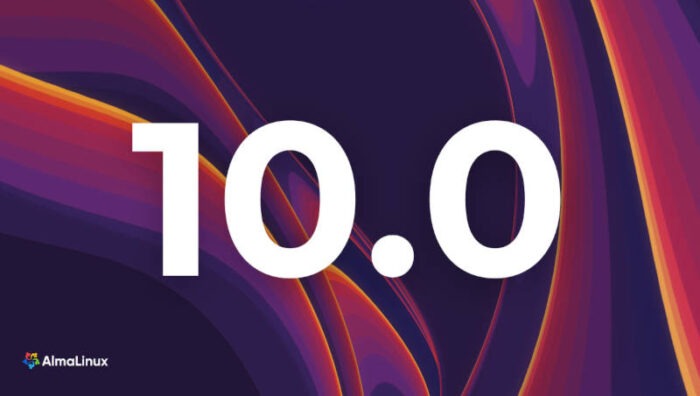While most of the RHEL clones are happy to be line-by-line copies of Red Hat’s pride and joy, AlmaLinux 10 strives to be a little bit more.

On Tuesday, exactly a week after the official release of Red Hat Enterprise Linux 10, AlmaLinux 10 reported for duty, ready to run mission critical workloads in production. This makes AlmaLinux the first to offer a feature parity clone of RHEL’s latest release, which is nothing new. That’s been the case since AlmaLinux got started three years or so ago.
That got me wondering if some kind of rush to be first out the door isn’t part of the game plan at the distro, so I asked benny Vasquez, the organization’s board chair and main go-to person for answers. She said that it partly is… but partly isn’t.
“We do, in fact, aim to get AlmaLinux releases out as soon as possible after RHEL,” she said. “While the ‘first’ title is always fun to have, we focus on serving our users, which means building quickly and testing thoroughly before it goes out the door. We just happen to be quick, too.”
Exactly Like RHEL, Except When It’s Not
Something else that’s become the norm with AlmaLinux is that it often contains features its users have been requesting, but that aren’t available in RHEL, which some might consider strange behavior from a clone. The reason the distro can do this is because it no longer attempts to be a line-by-line copy of RHEL — even though it essentially is. One advantage to this is that it allows the distro to add features that don’t exist in RHEL, while still being able to assure users that their software will run exactly the same on AlmaLinux as it would on the corresponding version of RHEL.
In some ways this is a secret weapon in AlmaLinux’s aresenal, which helps it keep the playing field level as Red Hat works to make sure that AlmaLinux, Rocky, and the other clones aren’t on equal footing with RHEL. An example here would be RHEL 10’s AI moxie, which the clones can’t copy. That’s mostly because, when it comes to AI, Red Hat is setting a new bar for openwashing. Although the company continues to preach the gospel of open, RHEL’s new AI capabilities aren’t going to be much of a benefit to the clones due to license restrictions, code availability, and other attempts by Red Hat to keep its AI IP under lock and key.
Frame Pointers
Adding features to AlmaLinux 10 that aren’t available in RHEL but which users have been requesting, which AlmaLinux is increasingly doing, might be a good counterbalance. AlmaLinux 10 ships with frame pointers enabled by default, for instance, which is something that user requests led the distro to introduce last fall to AlmaLinux Kitten, its CentOS Stream clone.
Frame pointers, which are CPU registers that maintain a fixed reference point throughout the execution of a program, are useful to both developers and operators for a variety of reasons. Devs can use them, for example, to make it easier to obtain accurate stack traces when debugging crashes or unexpected behavior, or as an aid in finding bottlenecks. Ops teams can take advantage of frame-pointer-based profiling to find and fix performance issues in live systems.
Because they come with a slight performance hit — less than two percent in most cases — they went out of vogue a little over a decade ago. Lately however, the likes of Google, Meta, Netflix, and Ubuntu have been bringing them back because their value outweighs the performance hit.
Additional Hardware Support
Other ways that AlmaLinux strays from RHEL’s norm is by making — or keeping — Enterprise Linux available to hardware that RHEL 10 doesn’t support.
Example: although AlmaLinux OS follows Red Hat’s lead and ships x86-64-v3 optimized binaries by default, it also makes the x86-64-v2 architecture available, allowing users on older hardware to continue to receive security updates for another 10 years. This support of v2 includes EPEL, the Extra Packages for Enterprise Linux, which are typically community-maintained and hosted on Fedora’s repositories.
“By default, EPEL follows Red Hat’s builds, which means that all third party packages for RHEL10 will be built for x86-64-v3,” Eduard Abdullin, AlmaLinux’s release and automation engineer said in Tuesday’s release announcement. “As we announced last week on our blog, we are happy to share that we are building EPEL packages to support users in their adoption of our x86-64-v2 release of AlmaLinux OS 10.”
These v2 EPEL releases will be hosted by AlmaLinux instead of Fedora.
In addition, AlmaLinux 10 also includes a tech-preview of KVM virtualization support for the IBM Power architecture, which Red Hat removed starting with RHEL 9. Abdullin said that this is being returned because its use is “fundamental for a number of AlmaLinux users,” including the Oregon State University Open Source Lab.
SPICE Returns and Making the Move to v10
Also by user request, AlmaLinux 10 returns SPICE, the Simple Protocol for Independent Computing Environments, that allows users to access and interact with a virtual machine’s desktop environment remotely and not just from the host server. SPICE support was dropped in RHEL 9.
“Starting with AlmaLinux 8.10 and 9.4, we re-enabled support for more than 150 devices that were removed upstream,” Abdullin explained. “Those additions continue in AlmaLinux OS 10.0. You can see the full list of devices in the AlmaLinux OS 10.0 release notes.”
Those who’ll be shifting loads from AlmaLinux 9 to 10 will probably want to wait a bit as the AlmaLinux folks get ELevate ready.
ELevate is the distro’s lift and shift tool to help users painlessly migrate, both across Enterprise Linux distros and between versions. Currently, ELevate support for migrating to AlmaLinux 10 isn’t ready, but the wait shouldn’t be long. benny Vasquez told FOSS Force that Elevate updates are already in the works and “should be released within a week or two at the latest.”
“In the meantime, you can help us test ELevate upgrades to AlmaLinux OS 10.0 Beta and AlmaLinux OS 10 Kitten to ensure a smoother, well-tested process,” Abdullin said. “Please refer to the ELevate Testing Guide and join the ~migration channel on the AlmaLinux Community Chat to stay updated.”
Also, if you want to find out more, you can read the full release notes on the wiki: AlmaLinux OS 10.0 Release Notes.
Christine Hall has been a journalist since 1971. In 2001, she began writing a weekly consumer computer column and started covering Linux and FOSS in 2002 after making the switch to GNU/Linux. Follow her on Twitter: @BrideOfLinux





